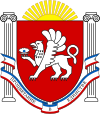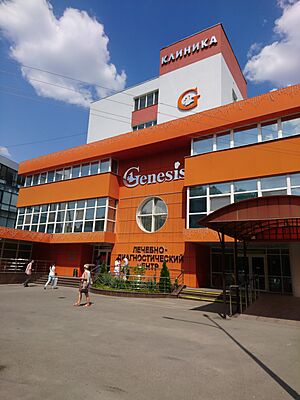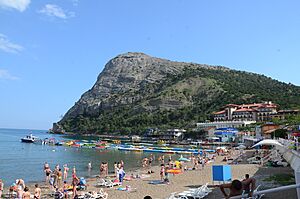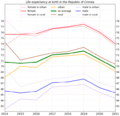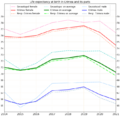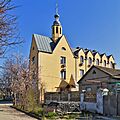Republic of Crimea (Russia) facts for kids
Quick facts for kids
Republic of Crimea
|
|||
|---|---|---|---|
|
Republic
|
|||
|
|||
| Anthem: Нивы и горы твои волшебны, Родина Nivy i gory tvoi volshebny, Rodina (Russian) "Your fields and mountains are magical, Motherland" |
|||
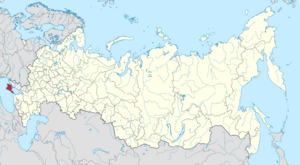
Location of the Republic of Crimea (Russia) (red)
in Russia (light yellow) |
|||

Location of the Republic of Crimea (Russia) (light yellow)
in the Crimean Peninsula |
|||
| Federal district | Southern | ||
| Economic region | North Caucasus | ||
| Capture of the Crimean parliament by Russian forces | 27 February 2014 | ||
| Annexation by Russia | 18 March 2014 | ||
| Administrative centre | Simferopol | ||
| Government | |||
| • Body | State Council | ||
| Area | |||
| • Total | 26,081 km2 (10,070 sq mi) | ||
| Population
(2021)
|
|||
| • Total | 1,934,630 | ||
| • Density | 74.1778/km2 (192.120/sq mi) | ||
| Languages | |||
| • Official | |||
| Time zone | UTC+3 (MSK) | ||
| License plates | 82 | ||
The Republic of Crimea is a republic of Russia. It covers most of the Crimean Peninsula, but not the city of Sevastopol. Before 2023, its land was part of the Autonomous Republic of Crimea in Ukraine. Russia took control of the peninsula in 2014. This action is not recognized by many countries around the world.
The main city and capital of the Republic of Crimea is Simferopol. It is the second-largest city on the Crimean Peninsula. In 2021, about 1,934,630 people lived in the Republic of Crimea.
Contents
Government and Politics
The State Council of Crimea is the main law-making body. It has 75 members. In an election held in September 2014, the United Russia party won 70 of these 75 seats.
The courts in Crimea are part of Russia's legal system. Decisions made by Ukrainian courts in Crimea before 2014 are still valid under Russian law.
The Council of Ministers handles the daily running of the government. It is led by the Head of the Republic of Crimea. The rules for how the State Council and Council of Ministers work are set by the Constitution of the Republic of Crimea and other local laws.
Some people in Crimea chose not to become Russian citizens. These people are not allowed to hold government or city jobs. By July 2015, 20,000 Crimeans had given up their Ukrainian citizenship. From 2014 to October 2016, over 8,800 Crimean residents received Ukrainian passports.
In September 2016, Crimea took part in the 2016 Russian legislative election.
Administrative Divisions
The Republic of Crimea uses the same administrative areas as the Autonomous Republic of Crimea did before. It is divided into 25 parts. These include 14 districts (called raions) and 11 city areas (called gorodskoj sovet or gorsovet).
- Districts
- Bakhchysarai Raion
- Bilohirsk Raion
- Dzhankoy Raion
- Kirovske Raion
- Krasnohvardiiske Raion
- Krasnoperekopsk Raion
- Lenine Raion
- Nyzhnohirskyi Raion
- Pervomaiske Raion
- Rozdolne Raion
- Saky Raion
- Simferopol Raion
- Sovietskyi Raion
- Chornomorske Raion
- City Areas
- Alushta Municipality
- Armyansk Municipality
- Dzhankoy Municipality
- Yevpatoria Municipality
- Kerch Municipality
- Krasnoperekopsk Municipality
- Saky Municipality
- Simferopol Municipality
- Sudak Municipality
- Feodosia Municipality
- Yalta Municipality
Geography and Demographics
Crimea is connected to mainland Ukraine by land. Ukraine still says that Crimea is part of its territory. Roads and railways connect them, but these crossings have been controlled by Russian troops since 2014.
Crimea does not have a land connection to Russia. Between 2014 and 2019, Russia built the Crimean Bridge. This huge bridge connects Crimea to Russia across the Kerch Strait. It opened for cars in 2018 and for trains in 2019. In October 2022, an explosion badly damaged the bridge.
Life Expectancy
In 2019, people in the Republic of Crimea lived for about 72.71 years on average. This was the highest life expectancy recorded there. However, during the COVID-19 pandemic, life expectancy dropped. In 2021, it was about 69.70 years. For males, it was 65.31 years, and for females, it was 73.96 years.
Languages
The Constitution of the Republic of Crimea states that there are three official languages:
A 2014 survey showed that most people in Crimea speak Russian as their native language (84%). About 7.9% speak Crimean Tatar. A smaller number speak Tatar (3.7%) and Ukrainian (3.3%).
In 2015, most students in primary and secondary schools chose to study in Russian.
- 96.74% studied in Russian.
- 2.76% studied in Crimean Tatar. About 5,083 students learned in Crimean Tatar in 53 schools.
- 0.5% studied in Ukrainian. About 949 students learned in Ukrainian in 22 schools.
In August 2014, the Education Minister said that no Ukrainian language classes would be formed for first-graders. This was because no parents asked for them. However, a Ukrainian school in Simferopol might have Ukrainian classes if enough parents requested it. The minister also noted that parents of first-graders mostly asked for Russian or Crimean Tatar language classes.
A report from 2015 by the Organization for Security and Cooperation in Europe (OSCE) said that the Republic of Crimea aimed to stop Ukrainian language teaching. This was done by putting pressure on schools, teachers, parents, and students.
Religion
Before 2014, most people in Crimea were Orthodox Christians. The Crimean Tatars were a Sunni Muslim minority. There were also smaller groups of Roman Catholics, Ukrainian Greek Catholics, Armenian Apostolic Christians, and Jewish people. In 2013, Orthodox Christians made up 58% of the population. Muslims were 15%, and 10% said they had beliefs but no specific religion.
Since 2014, the United Nations has reported that some religious minority groups and individuals have faced difficulties.
Economy
Crimea's economy relies on several things. These include tourism, farming, fishing, and mining. They grow crops like wheat, rice, and fruits. They also produce wine. The region has natural resources like iron, titanium, and manganese. Other industries include metalworking, shipbuilding, oil and gas, chemicals, and electronics.
Tourism
Tourism is very important for Crimea's economy. In 2014, about two million tourists visited Crimea. This included 300,000 people from Ukraine. In 2013, 3.5 million Ukrainian tourists and 1.5 million Russian tourists visited.
In August 2015, the government reported that 2.02 million tourists had visited Crimea that year. This was 16.5% more than in 2014. By January 2016, they said over 4 million tourists had visited in 2015. In 2018, over 6.4 million tourists visited Crimea.
Some tourists left Crimea after an airbase was attacked in August 2022. The Crimean Bridge explosion also affected tourism.
Museums and Art Galleries
Crimea has many interesting places to visit, including:
- Aivazovsky National Art Gallery
- Alexander Grin house museum
- Feodosia Money Museum
- Lapidarium, Kerch
- Livadia Palace
- Massandra Palace
- Simferopol Art Museum
- Museum of Vera Mukhina
- Vorontsov Palace (Alupka)
- White Dacha
Transport
Simferopol is the main hub for air travel in Crimea.
Aviation
- Simferopol International Airport
Rail
- Crimea Railway
Trolleybus Line
Crimea has a long trolleybus line, about 86 kilometers (53 miles) long. It is run by "Krymtrolleybus."
- Routes: Airport Simferopol — Simferopol — Alushta — Yalta
Roads
Major roads in Crimea include:
- European route E105: Syvash – Dzhankoy – North Crimean Canal – Simferopol – Alushta – Yalta
- Tavrida Highway A291: Kerch — Feodosia — Belogorsk — Simferopol — Bakhchisarai — Sevastopol
- European route E97: Dzhankoy – Feodosiya – Kerch
- Novorossiysk — Kerch highway A290: Crimean Bridge — Kerch
- Highway H19 (Ukraine): Yalta – Sevastopol
- Highway M18 (Ukraine): Yalta – Simferopol – Dzhankoy
- Highway H05 (Ukraine): Simferopol – Simferopol International Airport – Krasnoperekopsk
Education
Even though Russian, Ukrainian, and Crimean Tatar are official languages, reports suggest that Ukrainian and Crimean Tatar education is becoming less common.
Sport
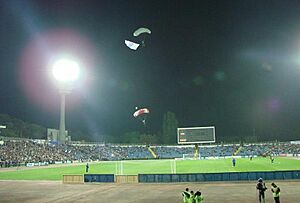
Football Clubs
- FC TSK Simferopol
- FC Krymteplytsia Molodizhne
- FC Ocean Kerch
- FC Rubin Yalta
Images for kids
See also
 In Spanish: República de Crimea para niños
In Spanish: República de Crimea para niños



